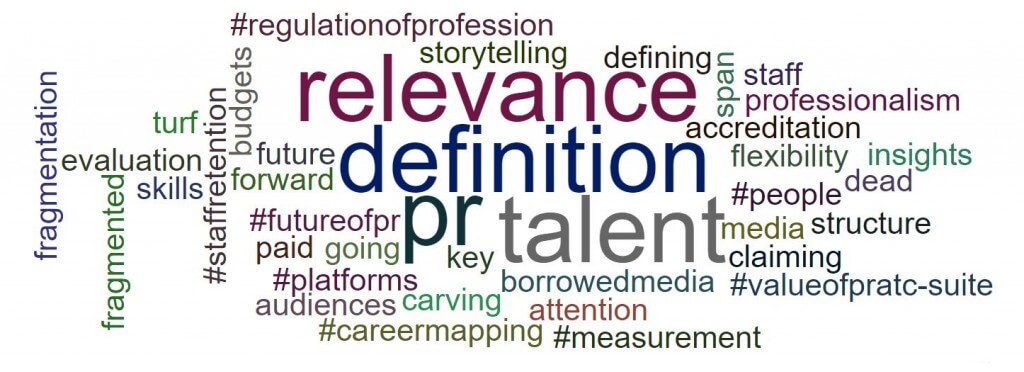5 Big Ideas about the Future of PR: Employee Amplification, Budget-Neutral News and More
Diversity is perhaps the hallmark of the future of PR. This realization was evident at the Creating the Future of PR Forum held in Sydney last week, when five speakers, each with very different perspectives, shared insights on how they see the industry developing. The speakers’ big ideas ranged from employee participation in company communications, to the role of branded content, evolving business models, and responses to the shift to consumer power.
Below are five brief snapshots of key ideas the speakers shared at the event.
Localization, personalization, and employee empowerment: Matt Trewin, General Manager – Retail & Media Communications, Telstra
Two thirds of Telstra’s 40,000 employees are interested in advocating for their company on social media, said Matt Trewin from Telstra. He revealed that Telstra and other large corporates are using social media for social engagement and empowerment. Key to this strategy is rethinking, “Who are our spokespeople?”
Taking a leaf out of Zappo's social playbook through empowering employees as spokespeople? @MattTTrewin #FutureofPR
— Kimberley Lee (@KimberleyL) October 15, 2015
The move to involve employees and local communities in PR is generating personalized content, Facebook pages with local audiences, and local programs and events. According to Trewin, these trends are emerging because PR is becoming “less centrally controlled and uptight”. Trewin believes that the future will see more organizations pilot and invest in social sharing platforms that can reach clients, prospects and locals directly.
PR professionals need balance: Tiffany Farrington, Founder of Social Diary
Working in PR used to be about “money and titles”. But now it is about “work-life balance”, said Tiffany Farrington, the Founder of the Social Diary online network for PR and media.
Tiff: The pursuit of wellbeing is becoming just as important as the pursuit of power & money #futureofpr #PR #flexibility
— Emma Dilemma (@emmadilemma1908) October 15, 2015
Regardless of whether work-life balance revolves around more family time, freedom, or more time to explore personal projects, the trend towards flexible workplaces is making its mark. The United States has seen a growing phenomenon called “Summer Fridays”, where staff can leave work at about 1 or 2 pm in the afternoon. The panel also mentioned LinkedIn’s recent decision to grant its employees flexible, on-demand holidays for extended durations. Similar strategies that resound with workers’ interests may entice young professionals to stay longer than the industry average: only 18 months with one company, for junior and mid-level staff.
Perfecting tailored and branded content: Tory Maguire, Editor-in-chief, Huffington Post Australia
Since becoming Editor-in-chief of the recently-launched HuffPost Australia, Tory Maguire has observed a growing challenge for PR: tailoring content to specific platforms.
Content for social media is not right for PR … Poorly targeted press release are a huge fail. Know your channels! @_Tors #futureofpr
— Kimberley Lee (@KimberleyL) October 15, 2015
Internal PR initiatives at the Huffington Post, in particular Partner Studio, are helping brands to attract more followers through authentic storytelling. The panel debated the newsworthiness of branded content, which for some speakers meant the ability of content to stand alone—and be engaging and shareable—if stripped of its brand message.
Evolving budgets and business models: Allison Lee, Director of Media and PR for Destination NSW
Allison Lee foregrounded the rise of “budget-neutral news solutions” in PR. Once the exclusive domain of PR related to the travel industry, budget-neutral news is becoming widely expected, Lee said. As a result, PR firms are increasing their budgets by partnering with large corporates.
New term: "budget neutral news" – media outlets expecting brands to pay for news production #FutureofPR
— Fierce Girl Finance (@bowhite) October 15, 2015
Another shift Lee observed is that more PR firms are viewing their staff as producers. This is a response to an emerging challenge for PR: developing new business models for broadcasted news based on the most engaged audiences—such as computer and tablet users—and the best return on investment.
Keeping up with consumer behavior: Jamie Verco, Lead Partner, N2N and Fuel Communications
We live in “an era of instant everything”, said PR innovator Jamie Verco. Immediacy is making consumers more discerning. Content, therefore, needs to be more relevant and convenient than ever before. PR agencies will need to adopt a range of strategies to keep apace with consumer behavior, including:
– diversifying agencies’ services to solve complex and non-traditional communications problems
– increasing agencies’ scale and networks of relationships
– developing professionals with world-class, specialist skills
– evolving agency structures to have a client-centric focus, and
– being open to new forms of communication and publication.
#futureofPR will require diverse services, specialist skills, scale & evolution of agency structures @jverco pic.twitter.com/gg2xJyibso
— N2N Communications (@n2nComm) October 15, 2015
Audience insights
Audience members at the Creating the Future of PR forum were asked to describe in a few words their vision of the key issues and opportunities shaping the future of PR. Here is the “word cloud” they generated through Twitter-to-screen live interaction:

Across the diversity of ideas expressed at the event, PR professionals proved to be sanguine about the future they are helping to create. The opportunity to reflect upon this future and the quality of the ideas shared made the Creating the Future of PR forum a standout event.
